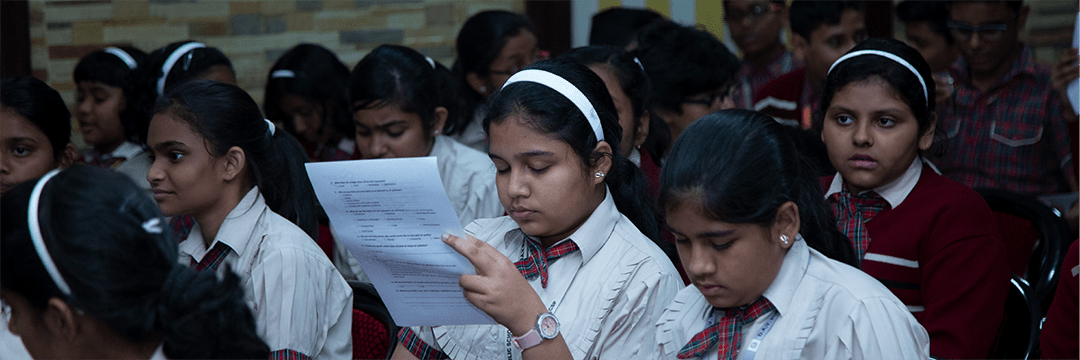Overview
Dawn of free economy in the ’90s has brought a sharp increase in industrialization, traffic and infrastructure in cities. An obvious outcome of industrialization is environmental degradation along with air pollution. School-going children are at the utmost vulnerability to diseases due to Air Pollution. Children in urban areas spent more than 50% of the time in school. So, it is important to raise awareness about air pollution in schools. A very first step to recognize possible health impacts is to monitor air pollution at schools. Clean Air Asia in partnership with Aurassure has created a strategy for making children, parents and schools aware of the importance of understanding air pollution and corelating this with children’s outdoor air exposure especially during play and physical activity.
‘Aurassure’ provides an IoT based device equipped with wireless sensors. It measures the concentration of various pollutants and calculates AQI. It acts as ‘One Number- One Colour-One Description’ to judge the Air Quality for the common man. Through an analysis of information generated on the public portal of ‘Aurassure’, it is now possible for School authorities and parents to visualize pollution regarding health risks in the development of their children.
Introduction
Rapid urbanization with haphazard administration in developing nations has proliferated several problems regarding the sustainability of cities, predominantly in Asia. Fortunately, there is no choice for the air we breathe and that’s why ceaseless ‘degradation of Air-Quality’ is of prime concern. Children and pregnant women are the most vulnerable citizens to the adverse impacts of air pollution. The horrific truth is death toll due to increased air pollution has reached half a million children annually, across the globe. If an awareness concerning the health impacts of air pollution on children grows, Schools are more likely to come up with feasible solutions.
Why school-going children are the most vulnerable to Air-pollution?
The factual expression of any society is the way in which it treats its children. They are the most sensitive and unprotected element in society. In children (between age 5 to 18) the immune and respiratory systems are not fully developed and their time spent outdoors is greater than adults. Kids also breathe more air per body weight than adults which in turn makes them more susceptible to ambient air pollutant exposures. Globally, seven major pollutants are considered while measuring Air Quality Index but it has been observed, Particulate pollution has adverse health impacts on children. Particulate Matter pollution essentially PM2.5 and PM10 can be trapped inside lungs and respiratory tract due to its small size. Prolonged exposure to particulate pollution increases the risk for development of asthma along with anxiety and depression. It can also affect lung development and develop a respiratory illness. Since most schools in urban areas are located near bottleneck city roads or big industrial polluters, the pollution level remains severe.
The necessity of Air-pollution monitoring at schools.
If it’s not measured, then it can’t be changed. First and foremost, an important step is to measure an emission. As for the accuracy of data increases, so does the possibility of an optimal solution. Data generated by meteorological institutes and government agencies are easily available but it doesn’t serve the purpose. It is necessary to identify major pollutants and pollution hotspots to predict their impacts on health. Precise and real-time data generated by monitors help to manage outside activities on high pollution days. Once, pollution data is known, it leads to control and eventually improvement.
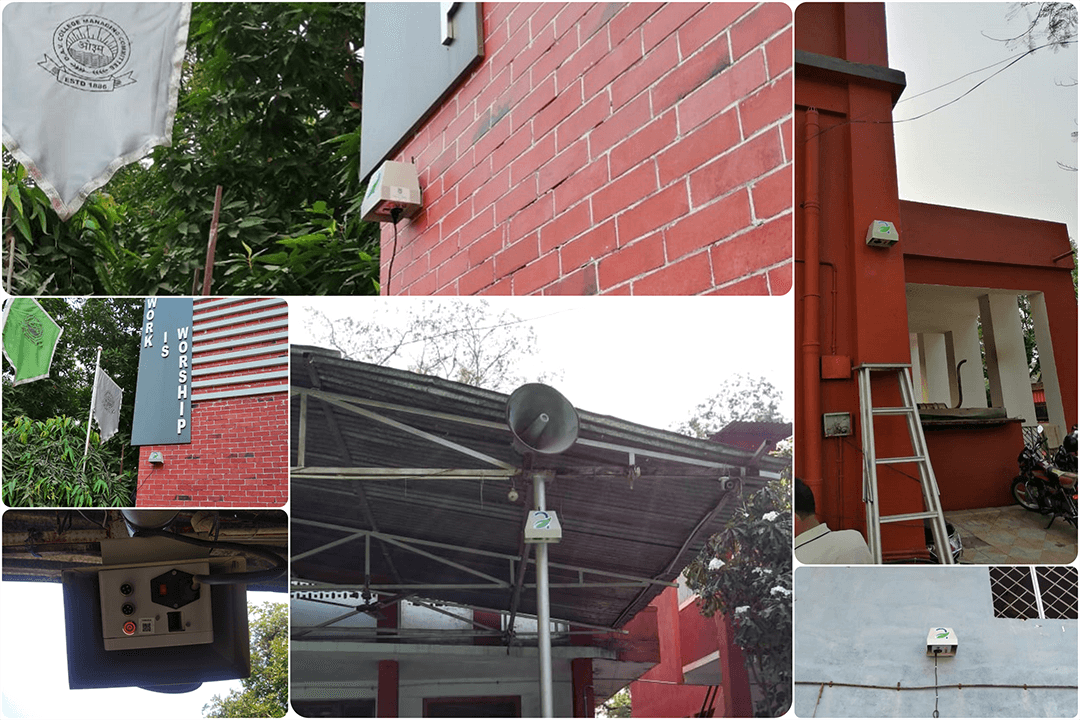
The Solution
‘Clean Air Asia’ in collaboration with ‘Aurassure’ is monitoring air quality data in various schools across the cities in India. Delhi, Nagpur and Bhubaneswar are three prime cities chosen across the country. Five schools from all three cities were selected strategically to deploy Air Quality Monitors at their campus. Deployed sensors can measure the precise concentration of PM2.5 and PM10 in the air. Based on concentration measured, it generates ‘Air Quality Index’. It is an easy figure for the public to determine whether the atmosphere is breathable or not! Data assimilated and results generated are published on a public portal. A public portal has been developed by Clean Air Asia and Aurassure to make understand the quality of air.
It gives the insight of following things-:
- Real-time data from monitoring stations.
- Air quality index which flashes for every few seconds.
- It shows Do’s and Don’ts to children based on the category of AQI.
The prime focus of the project is to improve awareness about ‘health impacts of Air pollution on school-going children’. Through the real-time monitoring and user-friendly solution, ‘Aurassure’ assures ‘clean air’ for posterity.
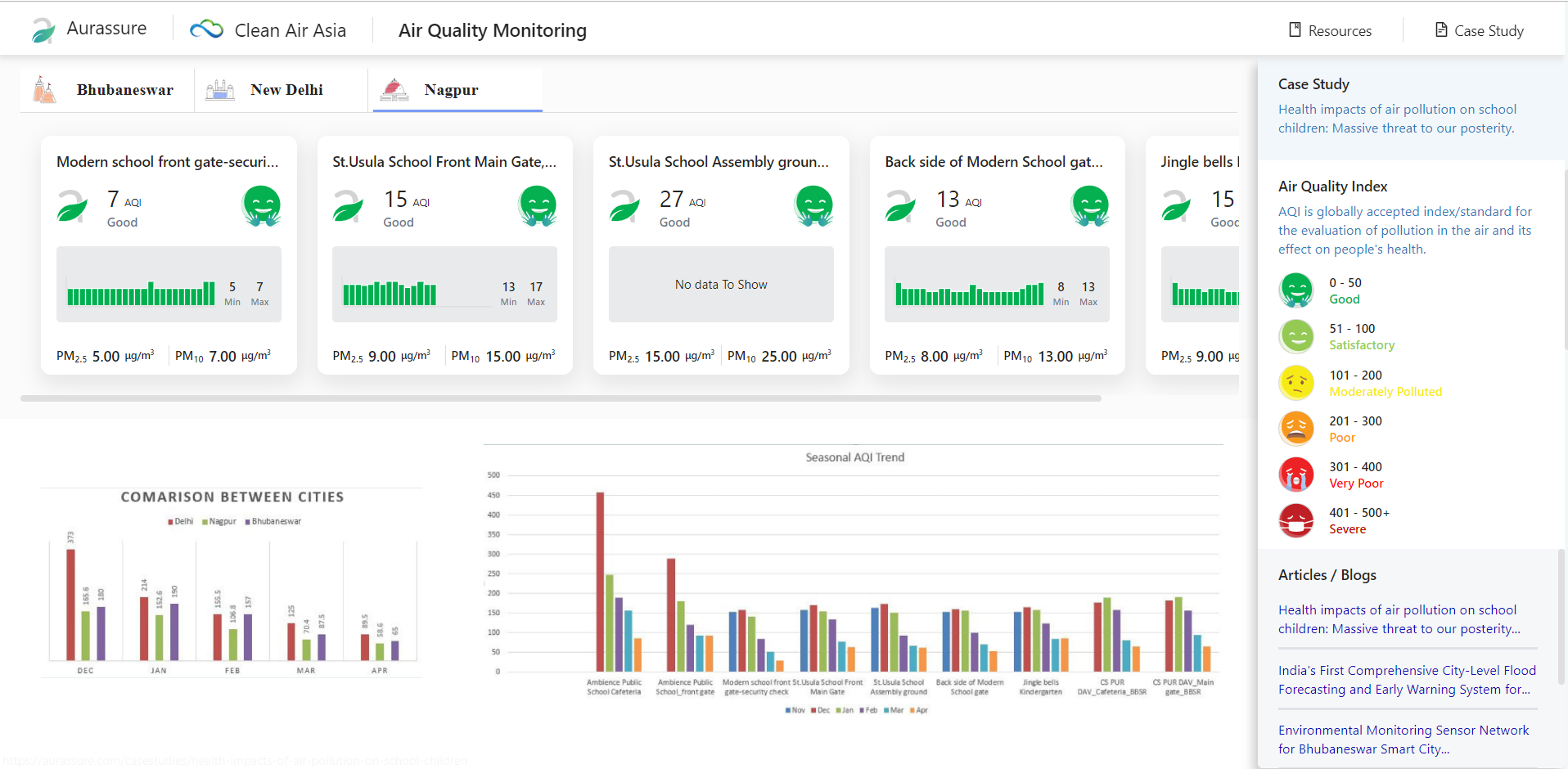
The digital display installed were integrated along with the sensors for automatic display of information’s and to publish other informative messages in an attractive manner.
Crucial Analysis
In Winter months especially, December has the worst air quality in a year. Tailpipe emission and road dust increase drastically in winter. These pollutants get trapped near the earth surface due to an interesting phenomenon called ‘Temperature inversion’. Garbage burning near roads and on open grounds is another activity observed in Indian cities during winter. Altogether, various different factors in winter ruin air quality near schools and overall in the city.
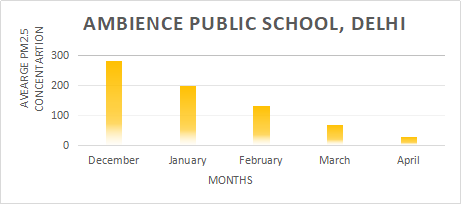
As the sun rises in the day, Air quality improves. It is one of the reasons, why summers have better air quality than the rest year. Congestion of vehicles near schools in the morning and evening, affect air quality. Many people still believe, air pollution peaks in the afternoon. It is quite natural to feel so but due to clear weather and ample ultraviolet radiation, air Pollution levels are minimum in the afternoon.
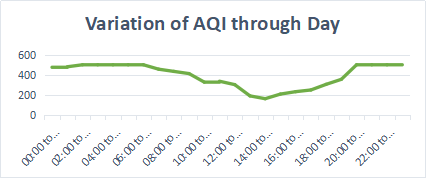
3.Among all three cities, Delhi has the highest pollution levels followed by Bhubaneswar. Nagpur has comparatively better air quality than the rest two cities.
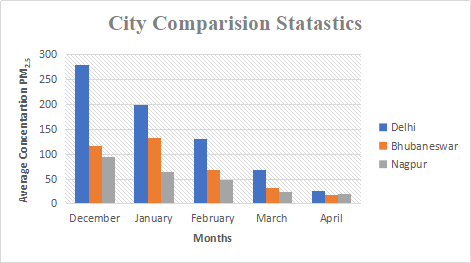
Location is another factor which effectively controls pollution levels in schools. Schools which are located within the city have high pollution levels than those which are outside the city. Along with location, vicinity of any industrial entity, e.g. power plant affects pollutant concentration. Though, a major factor is ‘wind direction’ which decides the dispersion of pollutant away from the source. In the following case, St. Ursula Girls High school located within the city while Jingle Bells Kindergarten is nearer to ‘Thermal Power Plant’.
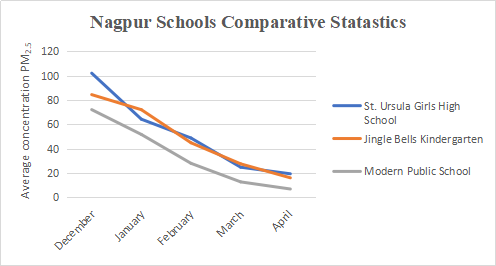
Air Quality Index depicts the daily air quality index. It shows how polluted or clean air is, and what might be health risks associated. A major pollutant is one whose AQI is considered as final AQI figure. At all stations in India, a major pollutant found to be PM2.5 irrespective of sources and location.
Traffic clutter at opening and closing time of schools makes drastic impacts on air quality. AQI showed sudden rise between 8 A.M to 9 A.M and 4 P.M to 5 P.M at school gates. It indicates vehicular pollution when parents drop their kids.
Recommendations and outcomes
- As real-time monitored air quality index is available, school authorities can analyze culprit sources and rectification can be done.
- Various trends in AQI are observed. Based on trends, outside activities and opening-closing time in various seasons can be scheduled effectively.
- Generally, during the opening-closing time of schools, bumper to bumper traffic is observed on roads near schools. It is advisable to opt for ‘student transport’ than private vehicles.
- Raising awareness in schools is one of the major goals of the project. Continuous projection of AQI and concerning suggestions are available on the public portal of ‘Aurassure’. It not just helps school authorities but also parents who are equally concerned about their child.
- Schools are able to introduce curriculum or they can conduct training for teachers, parents and educators to provide meticulous and the best information regarding air pollution and thus create a pool of informed children.
About Partners
Clean Air Asia
Clean Air Asia is an international non-governmental organization that leads with the mission for better air quality and healthier, more liveable cities in Asia. ‘Clean Air Asia (CAA)’s work in India involves engaging with Indian cities for better air quality management (AQM). This aligns with the overall CAA work program on broad air quality (AQ) interventions. Its work in India comprises providing scientific inputs to city governments for better air quality, sustainable transport/ mobility programs and education/ communication for cleaner air. The focus of CAA’s work in India is in cities with high impact potential, as well as potential for leveraging wider change.
Aurassure Private Limited
Aurassure brings in technologies such as things network-IoT and Big data to build a comprehensive ecosystem for smart cities empowering governments, administrations and decision makers to make better data driven decisions, making cities smart, safe and sustainable thus improving the lives of people and citizens inhabiting them and also helping industries meet their compliance requirements and cities to achieve their sustainable development goals through sensor nodes and data analysis.


